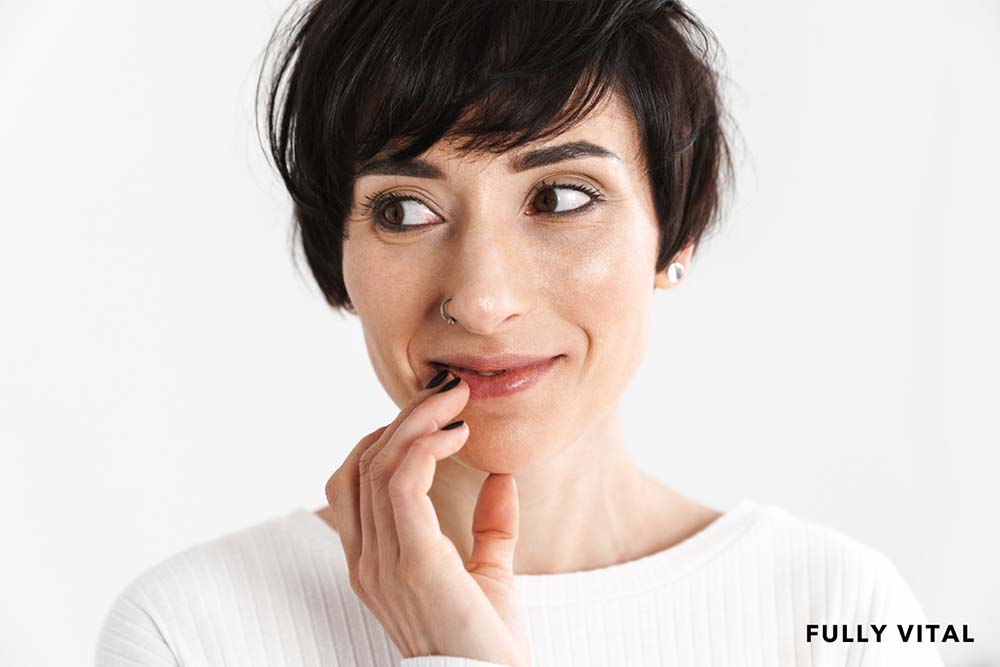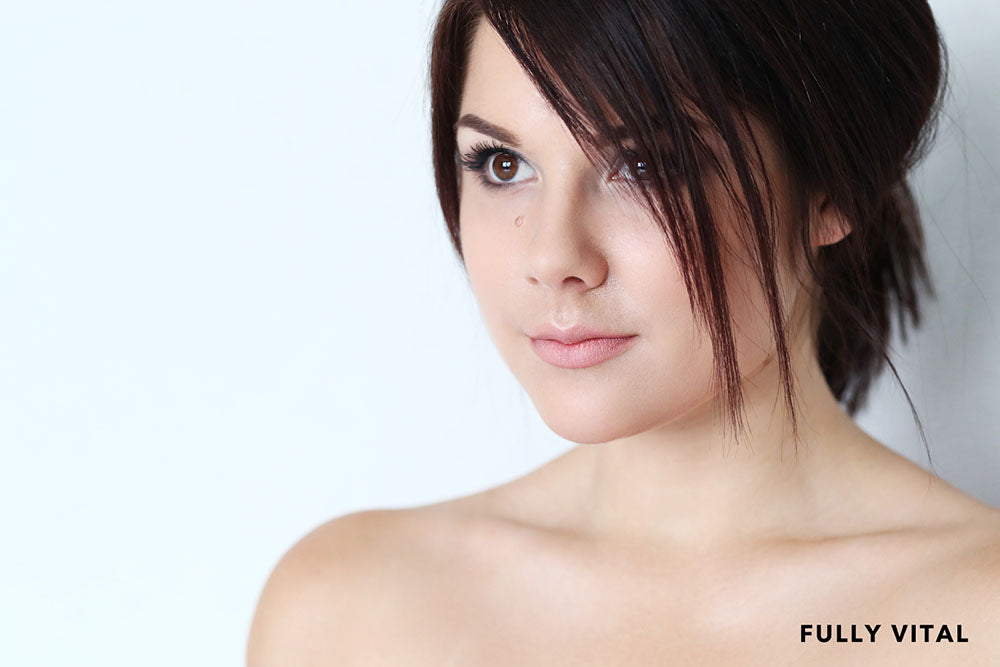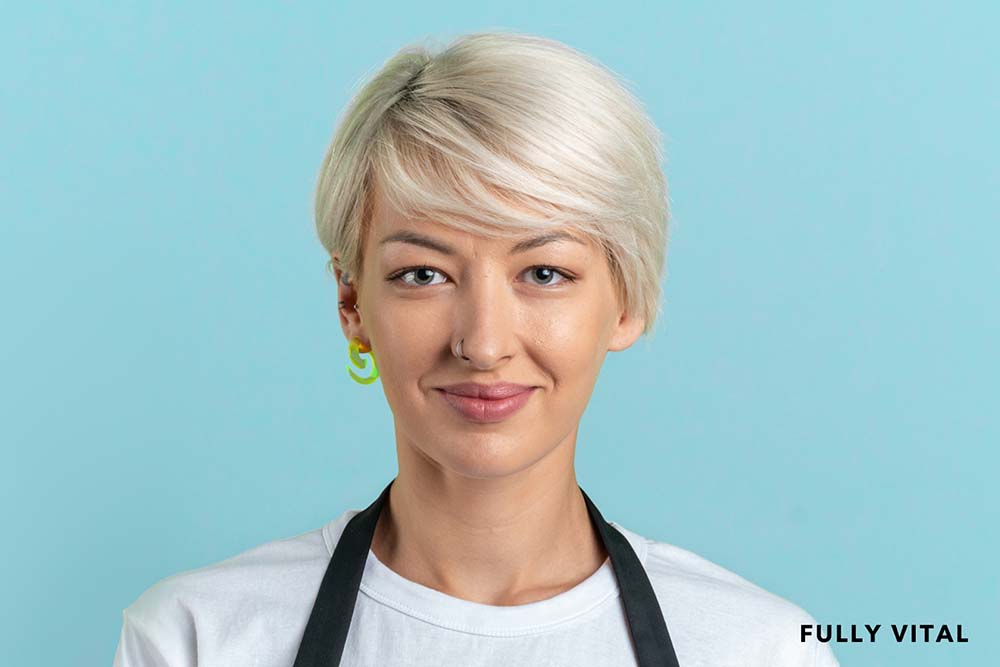
Textured Fringe: Adding Style And Volume To Your Hair
Welcome to our blog page dedicated to all things hair-related! In this article, we'll delve into the captivating world of textured fringe.
If you're a woman looking to add style, volume, and a touch of sophistication to your hair, textured fringe might be the perfect choice for you.
Whether you're curious about what textured fringe is, how it works, its benefits, or even considering alternative options, we've got you covered.
Join us as we explore the ins and outs of this trendy hairstyle, catering to women of all hair types who are eager to stimulate hair growth and express their unique personalities.
So, let's dive in and discover the wonders of textured fringe together!

I LOVE MY HAIR NOW
FullyVital hair serum and hair vitamins made tremendous improvements in my hair. I truly love my hair now.
Dorit S.,
What Is a Textured Fringe?
Textured fringe refers to a trendy hairstyle where the front section of hair is cut shorter than the rest and styled to create a textured, wispy look.
It adds flair, dimension, and movement to your overall hairstyle.(1)

Why Is Textured Fringe Important?
Textured fringe has gained popularity among women of all hair types as it offers numerous benefits.
It can transform a simple haircut into a fashionable and edgy style, providing versatility and enhancing facial features.(2)
How Does Textured Fringe Work?
Textured fringe works by creating contrast and visual interest in your hairstyle.
The shorter strands in the front draw attention to your face, while the textured layers add volume and movement.
It's a great way to update your look and add a touch of personality to your hair.(3)
What Are The Benefits Of Textured Fringe?
Enhanced Style
Textured fringe adds a touch of sophistication and modernity to any hairstyle, making it a versatile choice for various occasions.
Volume And Texture
The layers in textured fringe give your hair a voluminous and textured appearance, making it appear fuller and more dynamic.
Face Framing
The shorter length of the fringe draws attention to your facial features, accentuating your eyes, cheekbones, and jawline.
Versatility
Textured fringe can be styled in different ways, whether you want it sleek and polished or tousled and casual.
Are There Any Downsides To Textured Fringe?
While textured fringe offers numerous advantages, it's important to consider potential downsides, including:
Maintenance
Textured fringe may require more frequent trims to maintain its shape and length.
Styling Effort
Achieving the desired textured look may involve using styling products and tools, which can require additional time and effort.
Hair Growth Patterns
Individuals with certain hair types or growth patterns may find it challenging to style and maintain textured fringe.
What Are The Alternatives To Textured Fringe?
If textured fringe isn't your preferred hairstyle, there are alternative options to consider, such as:
Side-Swept Bangs
Side-swept bangs can create a softer and more subtle look while still framing the face.
Blunt Bangs
Blunt bangs offer a bold and statement-making style that can transform your overall appearance.
Layered Face-Framing Haircut
A layered haircut with longer layers around the face can provide a similar face-framing effect without the shorter fringe.
How To Achieve A Textured Fringe?
To achieve a fabulous textured fringe, follow these steps:
-
Consult A Professional: Visit a skilled hair stylist who specializes in textured cuts to ensure the best results.
-
Communicate Your Desired Look: Clearly explain your vision for a textured fringe, whether you want it soft and wispy or bold and edgy.
-
Consider Your Hair Type: Different hair types require different cutting and styling techniques, so your hairstylist will tailor the approach to suit your specific hair texture.
-
Cutting Technique: The hairstylist may use various cutting techniques, such as point cutting or razor cutting, to create texture and movement within the fringe.
-
Styling Products: Use texturizing products, such as sea salt sprays or volumizing mousses, to enhance the texture and hold of your fringe.
- Styling Tools: Experiment with styling tools like a round brush or flat iron to achieve different looks, from smooth and polished to tousled and carefree.
How Is A Textured Fringe Different From A Regular Fringe?
While both textured and regular fringes serve to frame the face, there are distinct differences between the two:
Textured Fringe
- Features varied lengths and layers within the fringe.
- Emphasizes movement, volume, and a wispy appearance.
- Offers a more modern and edgy look.
- Requires specific cutting and styling techniques to achieve the desired texture.
Regular Fringe
- Features a uniform length across the entire fringe.
- Provides a clean and polished appearance.
- Offers versatility and can be styled in various ways.
- Requires less maintenance and may suit individuals seeking a simpler, classic look.
What Are The Different Cutting Techniques Used To Create A Textured Fringe?
Professional hairstylists employ various cutting techniques to create a textured fringe.
Some common techniques include:
Point Cutting
The hairstylist uses scissors to cut into the ends of the hair at different angles, creating a textured, feathered effect.
Razor Cutting
A razor tool is used to gently remove sections of hair, resulting in a softer and more textured fringe.
Slide Cutting
This technique involves cutting the hair at a slight angle while keeping the scissors partially open, creating texture and movement.
Layering
Gradual layering within the fringe adds depth and texture, allowing the hair to fall naturally and frame the face.
Thinning Shears
These specialized scissors can be used to remove bulk and add texture to a thick fringe.
How Do I Style a Textured Fringe?
Styling your textured fringe is an exciting part of the process. Here are some tips to help you achieve your desired look:
-
Apply Texturizing Product: Start by applying a texturizing spray or mousse to damp hair to enhance the texture and hold of your fringe.
-
Blow Dry: Use a round brush to blow dry your fringe, lifting the roots and creating volume. Style it in the desired direction, either straight down or swept to the side.
-
Flat Iron Or Curling Wand: For added texture and dimension, use a flat iron or curling wand to create soft waves or curls in your fringe.
- Finishing Touches: Spritz a light-hold hairspray on your fringe to set the style and keep it in place throughout the day.
What Face Shapes Are Best Suited For A Textured Fringe?
While textured fringes can complement a variety of face shapes, certain shapes tend to pair exceptionally well:
Oval Face
Textured fringes work beautifully with oval faces, as the fringe adds softness and balances the overall proportions.
Heart-Shaped Face
The texture and volume of a fringe help create width around the forehead, balancing the narrower chin area.
Square Face
Textured fringes soften angular features and add a touch of femininity to square-shaped faces.
Round Face
A textured fringe with longer, face-framing layers can create the illusion of length and slim down a round face.
What Is The History Of Textured Fringe?
The history of textured fringe dates back to the early 20th century when fringes, in general, gained popularity.
However, the textured fringe as we know it today has evolved with changing fashion trends.
Here are some key points about the history of textured fringe:
1920s
In the Roaring Twenties, the iconic flapper style emerged, featuring short haircuts with textured fringes.
This era celebrated freedom, rebellion, and a departure from traditional hairstyles.
1960s
The textured fringe experienced a resurgence during the mod fashion movement.
Influenced by icons like Twiggy and Brigitte Bardot, textured fringes became a symbol of the era's edgy and fashionable style.
1990s
Textured fringes remained popular throughout the 1990s, with celebrities like Winona Ryder and Drew Barrymore showcasing the grunge-inspired, tousled fringe look.
What Is The Current Environment Of Textured Fringe?
Textured fringe is thriving in the current hair fashion landscape.
Here's an overview of the current environment surrounding textured fringe:
Celebrity Influence
Many celebrities, influencers, and style icons are sporting textured fringes, which contributes to its popularity and inspires individuals to try the look.
Runway And Red Carpet
Textured fringes often make appearances on runways and red carpets, solidifying their status as a fashionable and on-trend hairstyle.
Social Media Influence
Platforms like Instagram and TikTok have played a significant role in popularizing textured fringes.
Users share their own looks, tutorials, and styling tips, inspiring others to embrace this hairstyle.
Hairstyling Tools And Products
The availability of advanced hairstyling tools, such as specialized cutting shears and texturizing products, enables hairstylists to create intricate and customized textured fringe styles.
What Does The Future Hold For Textured Fringe?
The future of textured fringe looks promising, with continued innovation and evolution in hairstyling techniques and trends.
Here are some potential developments to look forward to:
Technological Advances
Advancements in hairstyling technology may lead to even more precise and customizable textured fringe techniques.
Virtual reality tools, for instance, could provide a more accurate visual representation of how different textured fringes would look on individuals.
Sustainability And Natural Texture
As sustainability becomes increasingly important in the beauty industry, we may see a rise in textured fringe styles that celebrate and enhance individuals' natural hair textures, reducing the need for excessive heat styling and chemical treatments.
Inclusive Representation
The future of textured fringe will likely involve a greater emphasis on inclusive representation, with a focus on celebrating diverse hair types and textures.
This will ensure that individuals of all backgrounds and hair characteristics can embrace and enjoy textured fringe styles.
Unlock The Full Potential Of Your Hair With Fully VitalDiscover our science-backed hair growth products that stop the aging process and nurture your locks to perfection. At Fully Vital, we believe in empowering you to have a healthier, more vibrant relationship with your hair.
Take charge of your hair's future and unlock its true potential. Experience the transformation with Fully Vital's hair growth products. |
Final Thoughts On Textured Fringe
Textured fringe is a stylish and versatile hairstyle that can add flair, volume, and dimension to your hair.
It has a rich history, from the iconic looks of the 1920s to its modern-day resurgence.
The current environment reflects the popularity of textured fringe among celebrities, influencers, and on fashion runways.
Looking ahead, the future of textured fringe holds exciting potential with advancements in technology and a focus on sustainability and inclusivity.
If you're looking to embrace the beauty of textured fringe and enhance your hair's health and vitality, consider exploring our range of hair growth products at Fully Vital.
Our products are designed to stop the aging process of your hair, promoting a healthy relationship with your locks.
Whether you're seeking to maintain your current fringe or experimenting with a new textured style, our products can help you achieve your hair goals.
Don't miss out on the opportunity to elevate your hair and enjoy the confidence that comes with a fabulous textured fringe.
Take the first step towards healthier, more vibrant hair with Fully Vital.
Frequently Asked Questions About Textured Fringe
Can I achieve textured fringe with any hair type?
Yes, textured fringe can be achieved with various hair types.
However, it's essential to work with a professional hairstylist who can adapt the cutting and styling techniques to suit your hair's unique characteristics.
How often should I trim my textured fringe?
To maintain the shape and length of your textured fringe, it's recommended to trim it every 4-6 weeks.
Regular trims will prevent it from becoming too long and losing its desired texture.
Are there any hair types that work well with a textured fringe?
Textured fringe can work well with various hair types.
While it may require some customization to suit individual characteristics, here are hair types that tend to work well with a textured fringe:
-
Straight Hair: Straight hair can easily achieve a sleek and wispy textured fringe.
-
Wavy Hair: Wavy hair adds natural texture and movement to a textured fringe.
- Curly Hair: Curly hair can create a unique and dynamic textured fringe with defined curls and volume.
What are some popular hairstyles that pair well with a textured fringe?
A textured fringe can complement various hairstyles, allowing for versatility and personal expression.
Here are some popular hairstyles that pair well with a textured fringe:
-
Pixie Cut: A textured fringe adds a playful and edgy touch to a pixie cut, enhancing its modern appeal.
-
Bob Cut: Whether it's a sleek bob or a layered bob, a textured fringe can add dimension and frame the face beautifully.
-
Shaggy Hairstyle: The combination of a shaggy hairstyle and a textured fringe creates a trendy and effortlessly chic look.
- Updos And Half-Up Styles: Incorporating a textured fringe into updos or half-up styles adds a stylish and unique element to the overall hairstyle.
How can accessories be incorporated to enhance a textured fringe hairstyle?
Accessories can elevate a textured fringe hairstyle and add an extra touch of flair. Consider these ideas:
-
Headbands: Opt for headbands with decorative details or patterns to highlight your textured fringe.
-
Hair Clips And Barrettes: Use stylish hair clips or barrettes to pin back a section of your fringe for a fashionable twist.
- Scarves Or Bandanas: Tie a scarf or bandana around your head, allowing your textured fringe to peek out for a boho-inspired look.
Can a textured fringe be achieved at home, or is it best left to professionals?
While it's possible to achieve a textured fringe at home, it's generally recommended to seek the expertise of a professional hairstylist, especially if you're new to cutting or styling your own hair.
A hairstylist can ensure the proper technique, precision, and desired outcome.
However, if you have experience and confidence in cutting your hair, you can try the following steps:
-
Research And Preparation: Study tutorials, gather the necessary tools (such as sharp scissors), and prepare your hair by washing and drying it.
-
Sectioning: Section off your hair, focusing on the area designated for the fringe.
-
Cutting Technique: Employ appropriate cutting techniques, such as point cutting or razor cutting, to achieve texture and movement.
- Styling: Follow the styling tips mentioned earlier in this article to style your textured fringe.
Are there any specific products recommended for maintaining a textured fringe?
To maintain a fabulous textured fringe, consider incorporating the following hair care products into your routine:
-
Texturizing Spray Or Powder: These products help enhance the texture and hold of your fringe, providing a lived-in look.
-
Dry Shampoo: Dry shampoo can refresh your fringe between washes while adding volume and texture.
- Light-Hold Hairspray: Use a light-hold hairspray to set your textured fringe and keep it in place throughout the day.
Do you need long hair for a textured fringe?
No, you don't necessarily need long hair for a textured fringe.
Textured fringes can be achieved with varying hair lengths, including short, medium, and long hair.
However, it's important to consider your hair's current length and consult with a hairstylist who can determine the best approach to achieve the desired texture and style.
Does A Fringe Make Hair Look Thicker?
Yes, a fringe can make the hair appear thicker.
By adding a fringe to your hairstyle, you create an additional layer of hair in the front, which can create the illusion of thicker hair overall.
The fringe adds volume and density to the front section, making the hair appear fuller and more abundant.
How do you get a fringe without cutting it?
If you want to achieve the look of a fringe without actually cutting your hair, there are a few temporary methods you can try:
-
Clip-In Fringe: Clip-in fringes are a popular option for those who want to experiment with a fringe without committing to a permanent cut.
These fringes are made of synthetic or real hair and can be easily attached to your natural hair using small clips.
They blend seamlessly with your hair, giving the appearance of a real fringe.
Clip-in fringes come in various styles, lengths, and colors, allowing you to choose the one that best suits your desired look.
-
Fringe Hair Extensions: Fringe hair extensions are similar to clip-in fringes but are designed specifically to mimic the look of a fringe. They typically have longer hair attached to the fringe portion, allowing you to blend it with the rest of your hair for a more seamless integration. Fringe extensions can be clipped in or taped in, depending on the type of extensions you choose.
- Fringe Wigs or Hair Toppers: Another option is to use a wig or a hair topper that has a built-in fringe. These are ideal if you want to dramatically change your look for a special occasion or if you simply want to experiment with different fringe styles. You can find wigs or hair toppers with various fringe lengths, textures, and colors to suit your preferences.
Sources
- 7 Hair Cuts That Will Make You Look and Feel Fabulous! - Lavish Hair Lounge. (2023, March 10). https://lavishhairlounge.com/hair-cut/
- 55 Short Haircuts for Round Faces That Stylists Love. (n.d.). Byrdie. Retrieved July 11, 2023, from https://www.byrdie.com/the-best-short-hairstyles-for-round-face-shapes-346952
- The Best Type of Bangs for Your Face Shape, According to Hair Pros. (2022, December 30). Good Housekeeping. https://www.goodhousekeeping.com/beauty/hair/g33267765/types-of-bangs/







